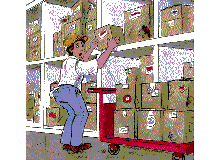

| Products | Light Pens or Wands | Search | Y2K Information |
| Printers | Data Collection | Software | Point of Sale |
What's a Bar Code?
![]() Light Pens or Wands
Light Pens or Wands
Hand-held contact scanners, or wands, are the oldest and most cost effective method of bar code scanning.
How Wands Work An operator manually places the scanner in contact with the bar code label. A tiny spot of light is projected through the scanner lens. As the scan spot is drawn across the bar code, reflections from each white space and light absorption from each black bar produce voltage variations that are amplified and shaped for decoding.
Using a contact device, the depth of field from bar code symbol to reader is usually limited to a maximum of 1/8 inch. The most common contact device is the wand or light pen. An application for a light pen is typically restricted to flat, smooth, easy to reach, and relatively short to medium length bar codes. In using a wand, the operator must maintain a constant speed and angle. The manual nature of these devices can reduce the first-time read rate, especially with poor quality symbols. Pens or wands require physical contact with the bar code thereby damaging the symbol over time and frequently need more than one scan to accurately read the bar code. The distinct advantage of wands is their low cost.
Wand technology is an excellent choice for many bar code applications. Specific advantages include: contact with the code makes it easy to determine which bar code is being read, and allows the operator to read bar codes of virtually any length; relative cost is low when compared to other scanning technologies; and with no moving parts, wands are the most rugged, compact and lightweight of the technologies available.
 The small, lightweight, inexpensive,
and rugged features of bar code wands permit their use in such
diverse applications as entering shipping data into on-line
distribution systems, work-in-process reporting, quality
assurance reporting, warehouse stock location, inventory control,
air freight tracking, and labor reporting.
The small, lightweight, inexpensive,
and rugged features of bar code wands permit their use in such
diverse applications as entering shipping data into on-line
distribution systems, work-in-process reporting, quality
assurance reporting, warehouse stock location, inventory control,
air freight tracking, and labor reporting.
Wands are not completely without their limitations, however. Some applications are simply not appropriate for contact scanning. Bar codes need to be of good quality, of a particular density (wand dependent), and reside on a flat hard surface if acceptable scanning performance is to be achieved. Some training is required for operators to develop an appropriate scanning technique since factors such as scan speed, wand angle, and pressure can adversely affect scanning performance if not performed properly. Finally, because this is a contact device, damage to the bar code label can occur if the proper paper stock or protective coating has not been used.